认识双向链表结构
双向链表:既可以从头遍历到尾,又可以从尾遍历到头。也就是说链表连接的过程是双向的,它的实现原理是:一个节点既有向前连接的引用,也有一个向后连接的引用。
单向链表不好解决的问题实例:
假设一个文本编辑用链表来存储文本,每一行用一个String对象存储在链表的一个节点中,当编辑器用户向下移动光标时,链表直接操作到下一个节点即可,但当用户将光标向上移动这个时候为了回到上一个节点我们可能需要从first开始依次走到想要的节点上
双向链表的缺点
每次在插入或删除某个节点时,都需要处理四个引用,而不是两个,实现起来会困难些;
相对于单向链表,所占内存空间更大一些;
但是,相对于双向链表的便利性而言,这些缺点微不足道。
双向链表的结构

双向链表不仅有head指针指向第一个节点,而且有tail指针指向最后一个节点;
每一个节点由三部分组成:item储存数据、prev指向前一个节点、next指向后一个节点;
双向链表的第一个节点的prev指向null;
双向链表的最后一个节点的next指向null;
双向链表常见的操作(方法)
append(element):向链表尾部添加一个新的项;
inset(position,element):向链表的特定位置插入一个新的项;
get(element):获取对应位置的元素;
indexOf(element):返回元素在链表中的索引,如果链表中没有元素就返回-1;
update(position,element):修改某个位置的元素;
removeAt(position):从链表的特定位置移除一项;
isEmpty():如果链表中不包含任何元素,返回trun,如果链表长度大于0则返回false;
size():返回链表包含的元素个数,与数组的length属性类似;
toString():由于链表项使用了Node类,就需要重写继承自JavaScript对象默认的toString方法,让其只输出元素的值;
forwardString():返回正向遍历节点字符串形式;
backwordString():返回反向遍历的节点的字符串形式;
JS封装双向链表类
创建双向链表类
创建双向链表类DoubleLinklist,并添加基本属性
//封装双向链表类
function DoubleLinklist(){
//封装内部类:节点类
function Node(data){
this.data = data
this.prev = null
this.next = null
}
//属性
this.head = null
this.tail ==null
this.length = 0
}
append(element)
//append方法
DoubleLinklist.prototype.append = data => {
//1.根据data创建新节点
let newNode = new Node(data)
//2.添加节点
//情况1:添加的是第一个节点
if (this.length == 0) {
this.tail = newNode
this.head = newNode
//情况2:添加的不是第一个节点
}else {
newNode.prev = this.tail
this.tail.next = newNode
this.tail = newNode
}
//3.length+1
this.length += 1
}
测试代码
//测试代码
//1.创建双向链表
let list = new DoubleLinklist()
//2.测试append方法
list.append('aaa')
list.append('bbb')
list.append('ccc')
console.log(list);
过程详解:
添加节点时分为多种情况:
情况1:添加的是第一个节点:只需要让head和tail都指向新节点即可;
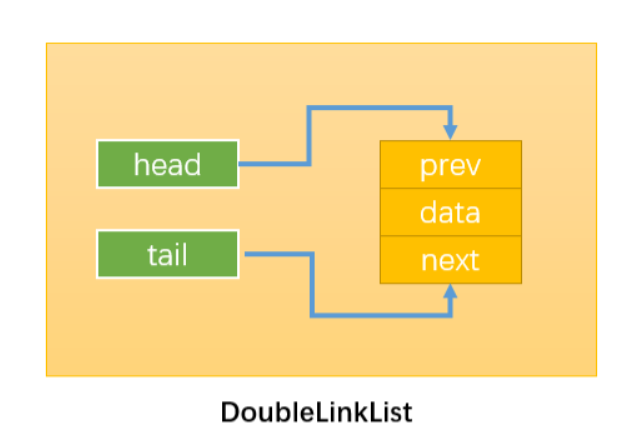
情况2:添加的不是第一个节点,如下图所示:只需要改变相关引用的指向即可。
通过:newNode.prev = this.tail:建立指向1;
通过:this.tail.next = newNode:建立指向2;
通过:this.tail = newNode:建立指向3
要注意改变变量指向的顺序,最后修改tail指向,这样未修改前tail始终指向原链表的最后一个节点。


toString()汇总
//将链表转变为字符串形式
//一.toString方法
DoubleLinklist.prototype.toString = () => {
return this.backwardString()
}
//二.forwardString方法
DoubleLinklist.prototype.forwardString = () => {
//1.定义变量
let current =this.tail
let resultString = ""
//2.依次向前遍历,获取每一个节点
while (current) {
resultString += current.data + "--"
current = current.prev
}
return resultString
}
//三.backwardString方法
DoubleLinklist.prototype.backwardString = () => {
//1.定义变量
let current = this.head
let resultString = ""
//2.依次向后遍历,获取每一个节点
while (current) {
resultString += current.data + "--"
current = current.next
}
return resultString
}
测试代码
//测试代码
//1.创建双向链表
let list = new DoubleLinklist()
//2.测试字符串方法
list.append('aaa')
list.append('bbb')
list.append('ccc')
console.log(list.toString());
console.log(list.forwardString());
console.log(list.backwardString());
过程详解:
三种获取字符串的方法:toString()、forwardString()、backwardString()实现原理相似,仅以backWardString方法为例:
定义current变量记录当前指向的节点。首先让current指向第一个节点,然后通过 current = current.next 依次向后遍历。在while循环中以(current)作为条件遍历链表,只要current != null就一直遍历,由此可获取链表所有节点的数据。
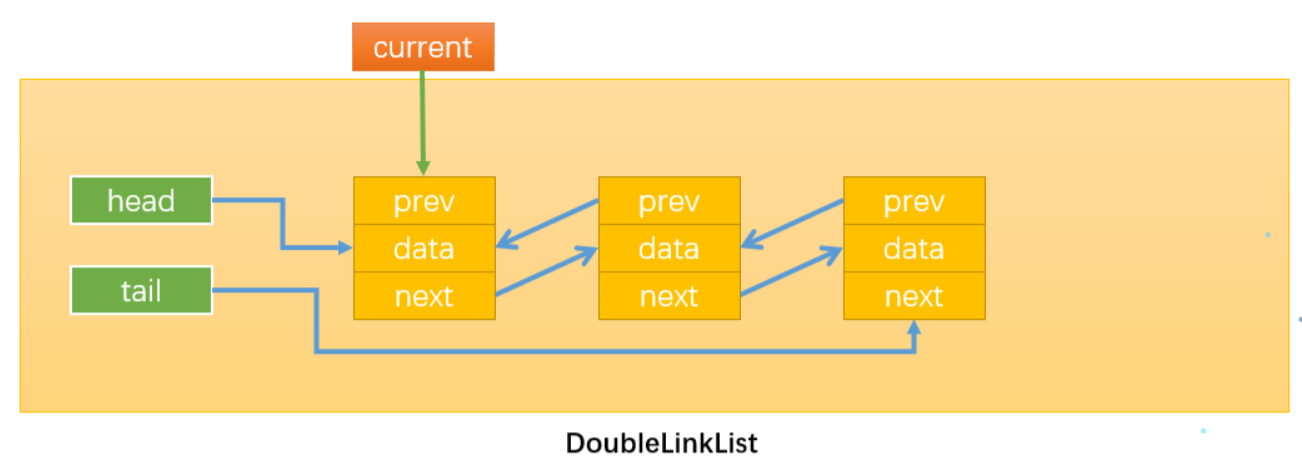
insert(position,element)
//insert方法
DoubleLinklist.prototype.insert = (position, data) => {
//1.越界判断
if (position < 0 || position > this.length) return false
//2.根据data创建新的节点
let newNode = new Node(data)
//3.插入新节点
//原链表为空
//情况1:插入的newNode是第一个节点
if (this.length == 0) {
this.head = newNode
this.tail = newNode
//原链表不为空
}else {
//情况2:position == 0
if (position == 0) {
this.head.prev = newNode
newNode.next = this.head
this.head = newNode
//情况3:position == this.length
} else if(position == this.length){
this.tail.next = newNode
newNode.prev = this.tail
this.tail = newNode
//情况4:0 < position < this.length
}else{
let current = this.head
let index = 0
while(index++ < position){
current = current.next
}
//修改pos位置前后节点变量的指向
newNode.next = current
newNode.prev = current.prev
current.prev.next = newNode
current.prev = newNode
}
}
//4.length+1
this.length += 1
return true//返回true表示插入成功
}
测试代码
//测试代码
//1.创建双向链表
let list = new DoubleLinklist()
//2.测试insert方法
list.insert(0, '插入链表的第一个元素')
list.insert(0, '在链表首部插入元素')
list.insert(1, '在链表中间插入元素')
list.insert(3, '在链表尾部插入元素')
console.log(list);
alert(list)
过程详解:
插入节点可分为多种情况:
当原链表为空时:
情况1:插入的新节点是链表的第一个节点;只需要让head和tail都指向newNode即可。
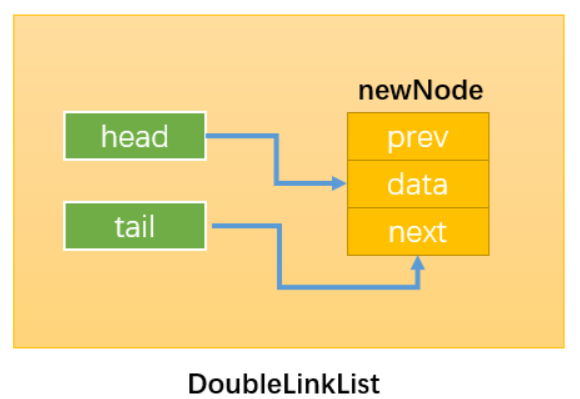
当原链表不为空时:
情况2:当position == 0,即在链表的首部添加节点:如下图所示:
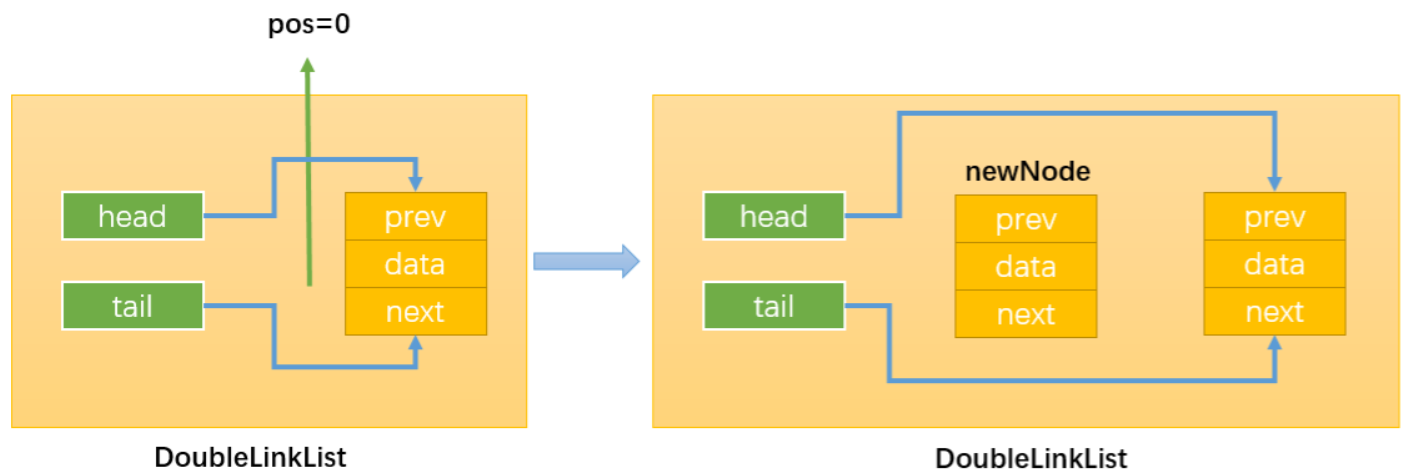
首先,通过:this.head.prev = newNode,改变指向1;
然后,通过:newNode.next = this.head,改变指向2;
最后,通过:this.head = newNode,改变指向3;

情况3:position == this.length,即在链表的尾部添加节点,如下图所示:
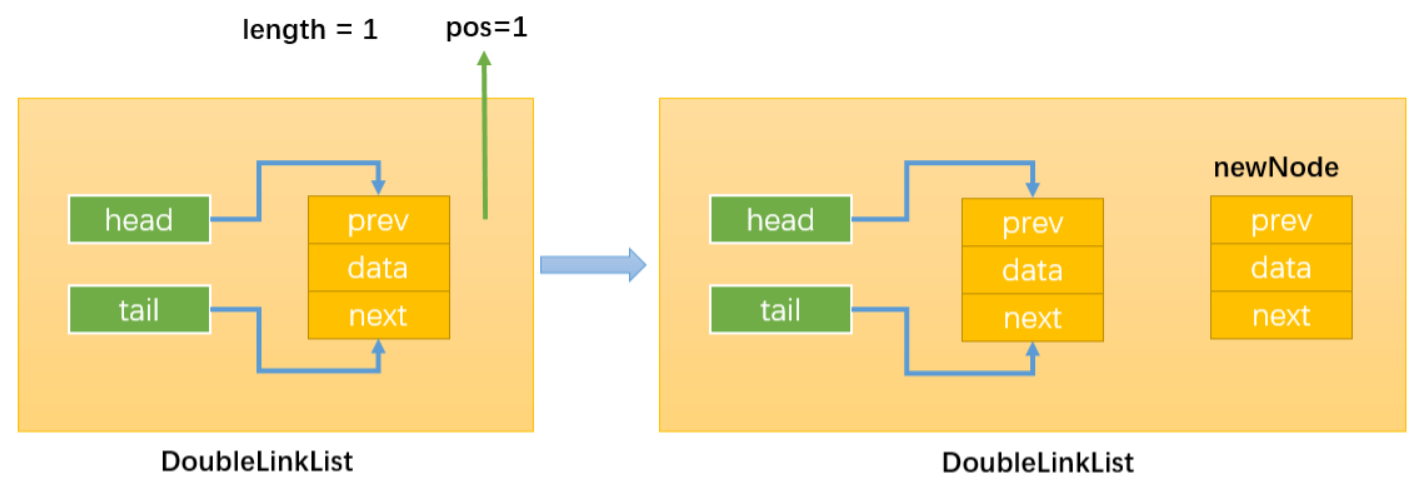
首先,通过:this.tail.next = newNode,改变指向1;(注意这里使用this.tail指向原链表最后一个节点,而不是this.head。因为当length>1时,this.head != this.tail。)
然后,通过:newNode.prev = this.tail,改变指向2;
最后,通过:this.tail = newNode,改变指向3;
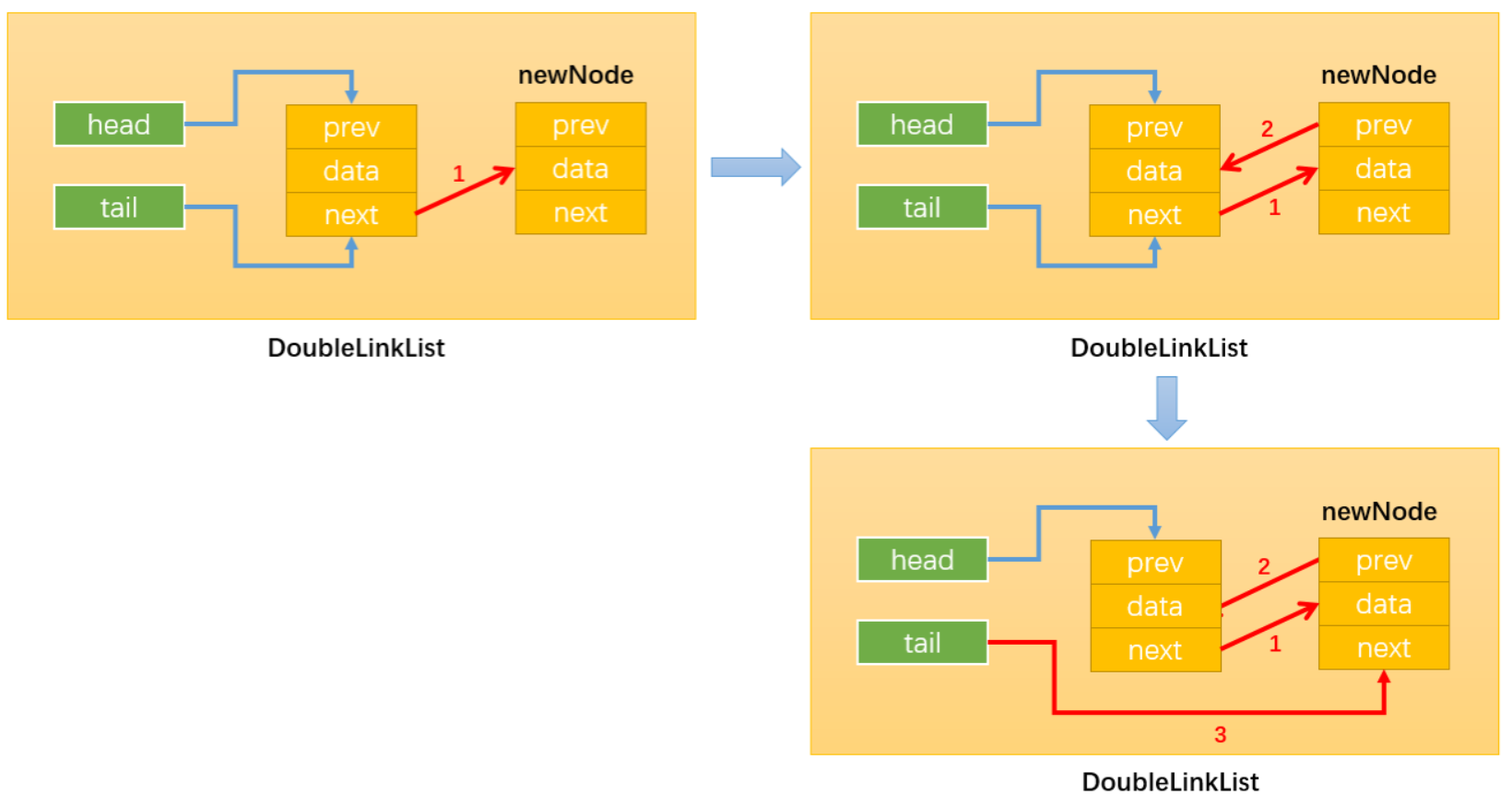
情况4:0 < position < this.length,即在链表的中间插入新节点,假设在position = 1的位置插入,如下图所示:
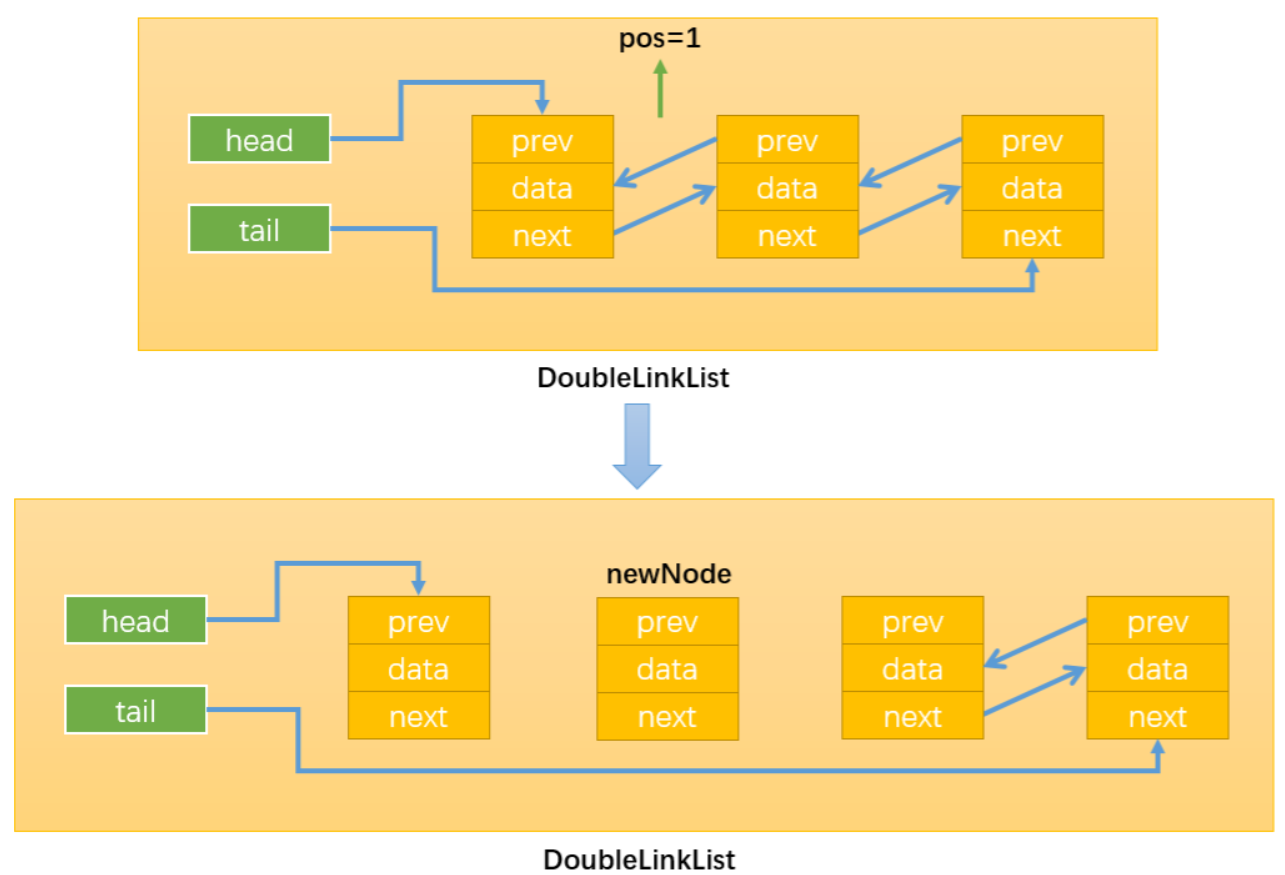
首先,需要定义变量current按照之前的思路,通过while循环找到position位置的后一个节点,循环结束后index = position

如下图所示:当position = 1时,current就指向了Node2。这样操作current就等同于间接地操作Node2,还可以通过current.prev间接获取Node1。得到了newNode的前一个节点和后一个节点就可以通过改变它们的prev和next变量的指向来插入newNode了。
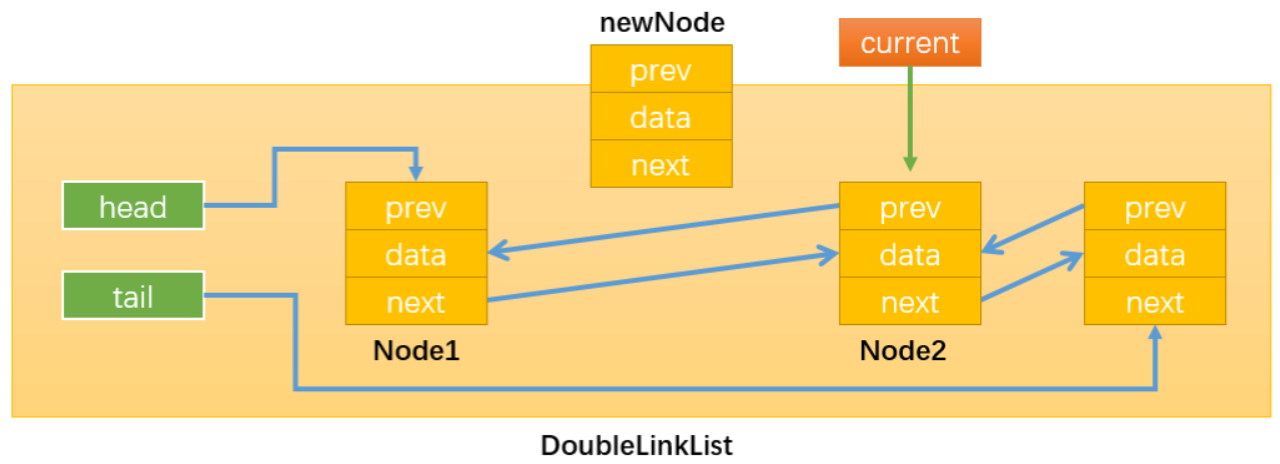
通过:newNode.next = current,改变指向1;
通过:newNode.prev = current.prev,改变指向2;
通过:current.prev.next = newNode,改变指向3;
注意必须最后才修改current.prev的指向,不然就无法通过current.prev获取需要操作的Node1了。
通过:current.prev = current,改变指向4;
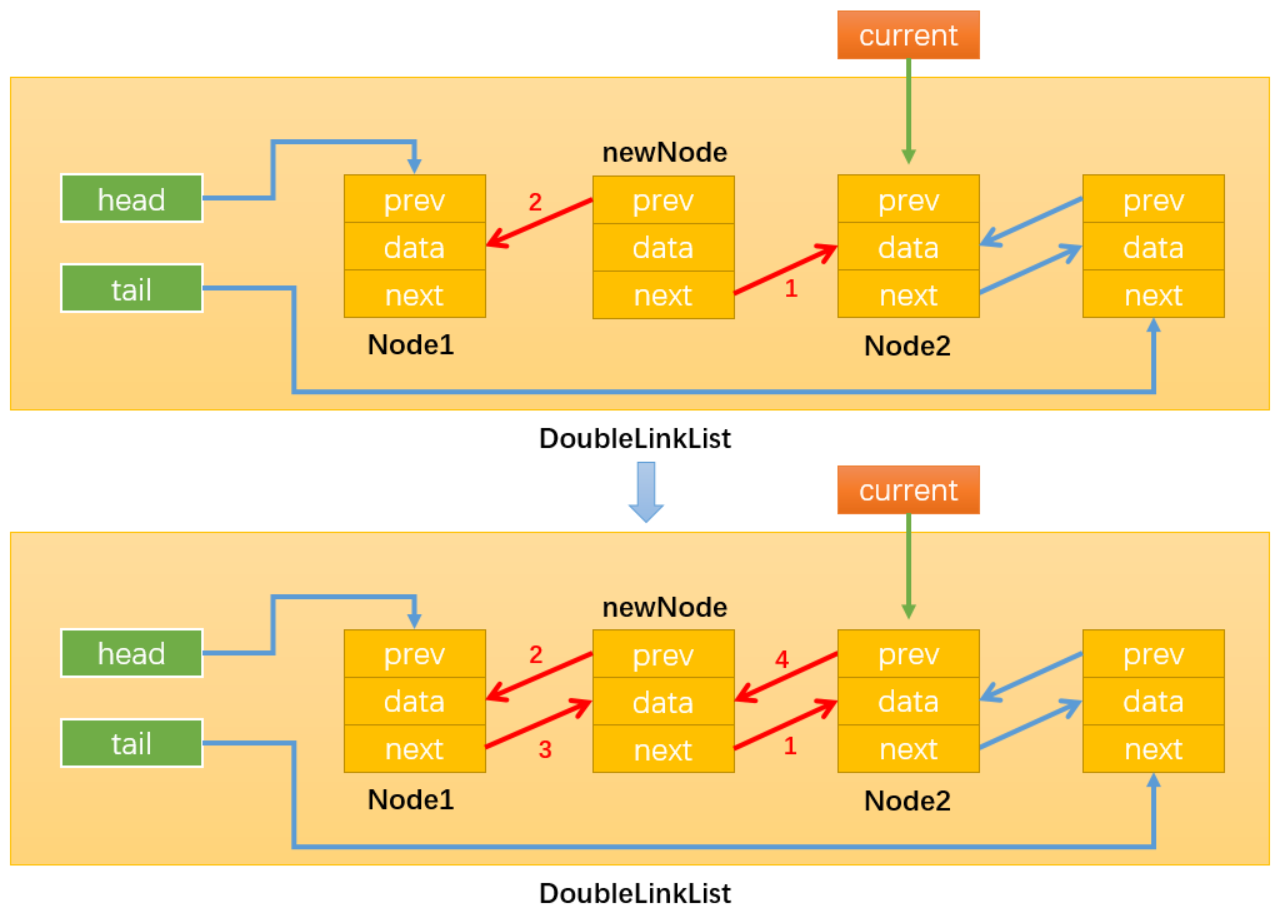
get(position)
//get方法
DoubleLinklist.prototype.get = position => {
//1.越界判断
if (position < 0 || position >= this.length) {//获取元素时position不能等于length
return null
}
//2.获取元素
let current = null
let index = 0
//this.length / 2 > position:从头开始遍历
if ((this.length / 2) > position) {
current = this.head
while(index++ < position){
current = current.next
}
//this.length / 2 =< position:从尾开始遍历
}else{
current = this.tail
index = this.length - 1
while(index-- > position){
current = current.prev
}
}
return current.data
}
测试代码
//测试代码
//1.创建双向链表
let list = new DoubleLinklist()
//2.测试get方法
list.append('a')
list.append('b')
list.append('b1')
list.append('b2')
list.append('b3')
list.append('b4')
list.append('b5')
list.append('b6')
list.append('b7')
console.log(list.get(0));
console.log(list.get(7));
过程详解:
定义两个变量current和index,按照之前的思路通过while循环遍历分别获取当前节点和对应的索引值index,直到找到需要获取的position位置后的一个节点,此时index = pos =x,然后return current.data即可。
如果链表的节点数量很多时,这种查找方式效率不高,改进方法为:
一定要通过this.length来获取链表的节点数否则就会报错。
当this.length / 2 > position:从头(head)开始遍历;
当this.length / 2 < position:从尾(tail)开始遍历;
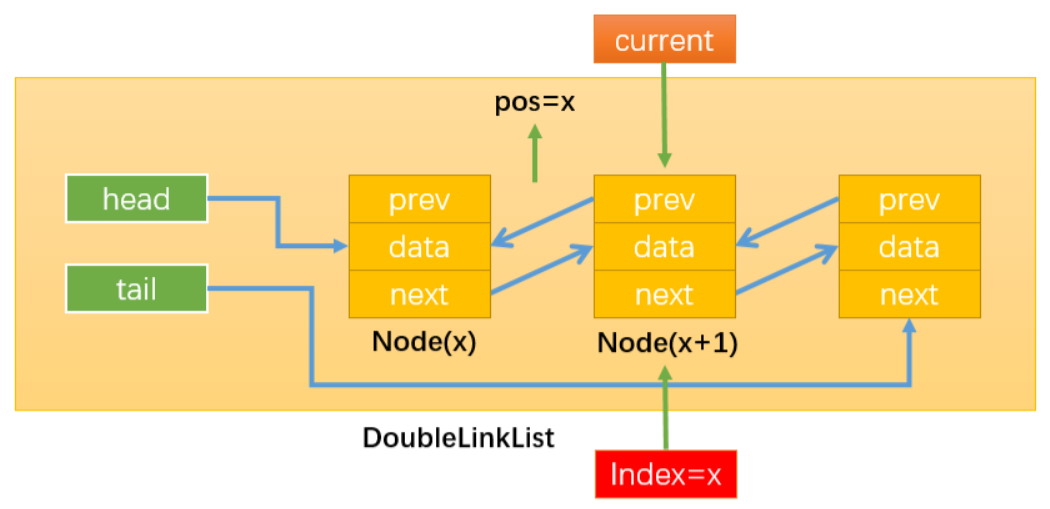
indexOf(element)
//indexOf方法
DoubleLinklist.prototype.indexOf = data => {
//1.定义变量
let current = this.head
let index = 0
//2.遍历链表,查找与data相同的节点
while(current){
if (current.data == data) {
return index
}
current = current.next
index += 1
}
return -1
}
测试代码
//测试代码
//1.创建双向链表
let list = new DoubleLinklist()
//2.测试indexOf方法
list.append('a')
list.append('b')
list.append('c')
console.log(list.indexOf('a'));
console.log(list.indexOf('c'));
过程详解:
以(current)作为条件,通过while循环遍历链表中的所有节点(停止条件为current = null)。在遍历每个节点时将current指向的当前节点的data和传入的data进行比较即可。
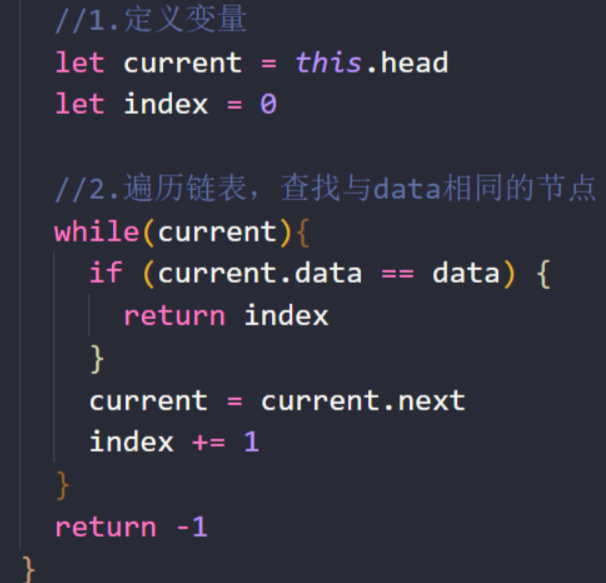
update(position,element)
//update方法
DoubleLinklist.prototype.update = (position, newData) => {
//1.越界判断
if (position < 0 || position >= this.length) {
return false
}
//2.寻找正确的节点
let current = this.head
let index = 0
//this.length / 2 > position:从头开始遍历
if (this.length / 2 > position) {
while(index++ < position){
current = current.next
}
//this.length / 2 =< position:从尾开始遍历
}else{
current = this.tail
index = this.length - 1
while (index -- > position) {
current = current.prev
}
}
//3.修改找到节点的data
current.data = newData
return true//表示成功修改
}
测试代码
//测试代码
//1.创建双向链表
let list = new DoubleLinklist()
//2.测试update方法
list.append('a')
list.append('b')
console.log(list.update(1, 'c'));
console.log(list);
过程详解:
以(index++ < position)为条件,通过while循环遍历链表中的节点(停止条件为index = position)。循环结束后,current指向需要修改的节点。
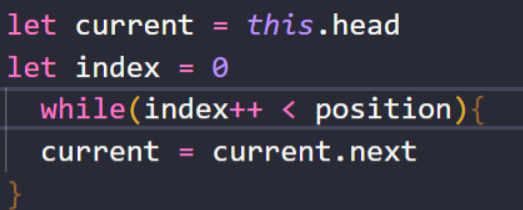
removeAt(position)
//removeAt方法
DoubleLinklist.prototype.removeAt = position => {
//1.越界判断
if (position < 0 || position >= this.length) {
return null
}
//2.删除节点
//当链表中length == 1
//情况1:链表只有一个节点
let current = this.head//定义在最上面方便以下各种情况返回current.data
if (this.length == 1) {
this.head = null
this.tail = null
//当链表中length > 1
} else{
//情况2:删除第一个节点
if (position == 0) {
this.head.next.prev = null
this.head = this.head.next
//情况3:删除最后一个节点
}else if(position == this.length - 1){
current = this.tail//该情况下返回被删除的最后一个节点
this.tail.prev.next = null
this.tail = this.tail.prev
}else{
//情况4:删除链表中间的节点
let index = 0
while(index++ < position){
current = current.next
}
current.next.prev = current.prev
current.prev.next = current.next
}
}
//3.length -= 1
this.length -= 1
return current.data//返回被删除节点的数据
}
测试代码
//测试代码
//1.创建双向链表
let list = new DoubleLinklist()
//2.测试removeAt方法
list.append('a')
list.append('b')
list.append('c')
console.log(list.removeAt(1));
console.log(list);
过程详解:
删除节点时有多种情况:
当链表的length = 1时:
情况1:删除链表中的所有节点:只需要让链表的head和tail指向null即可。

当链表的length > 1时:
情况2:删除链表中的第一个节点:
通过:this.head.next.prev = null,改变指向1;
通过:this.head = this.head.next,改变指向2;
虽然Node1有引用指向其它节点,但是没有引用指向Node1,那么Node1会被自动回收。
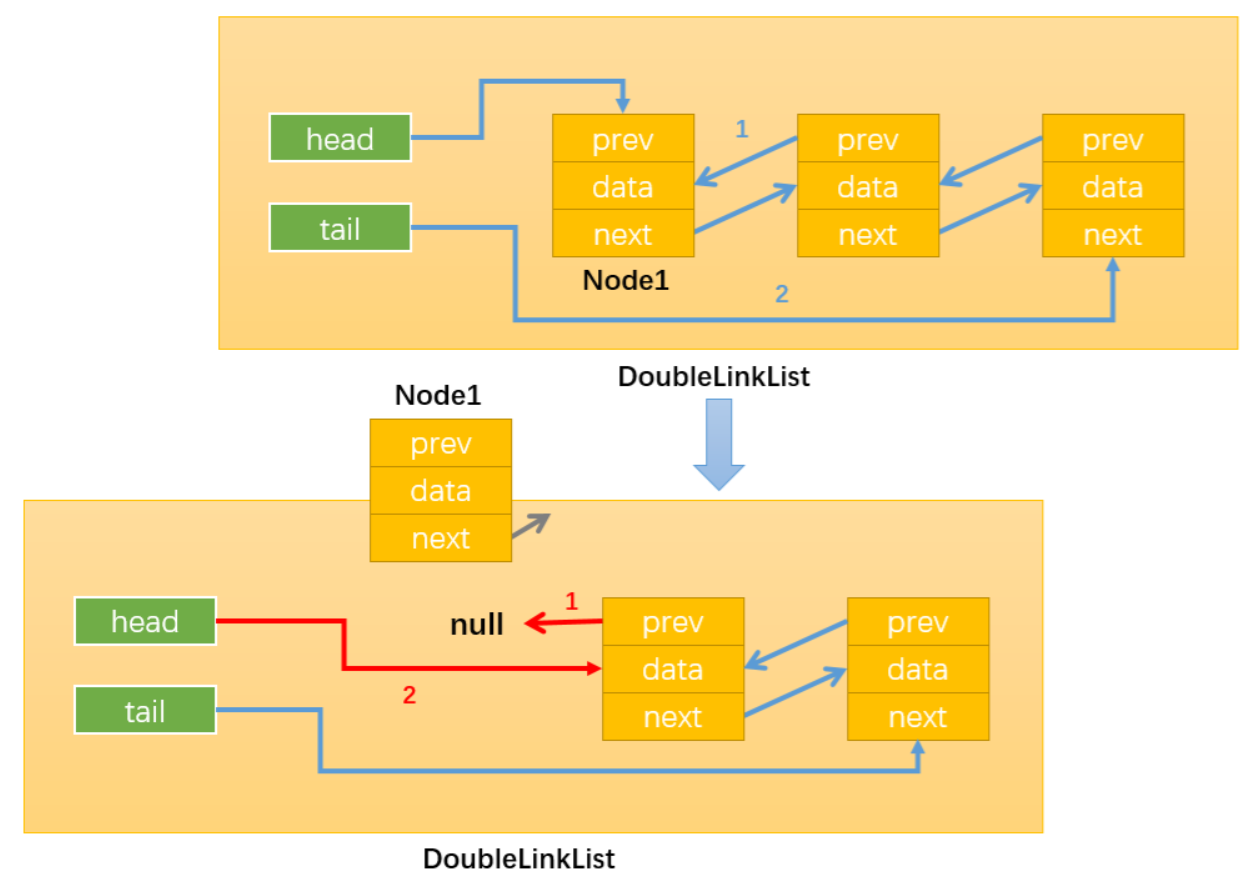
情况3:删除链表中的最后一个节点:
通过:this.tail.prev.next = null,修改指向1;
通过:this.tail = this.tail.prev,修改指向2;
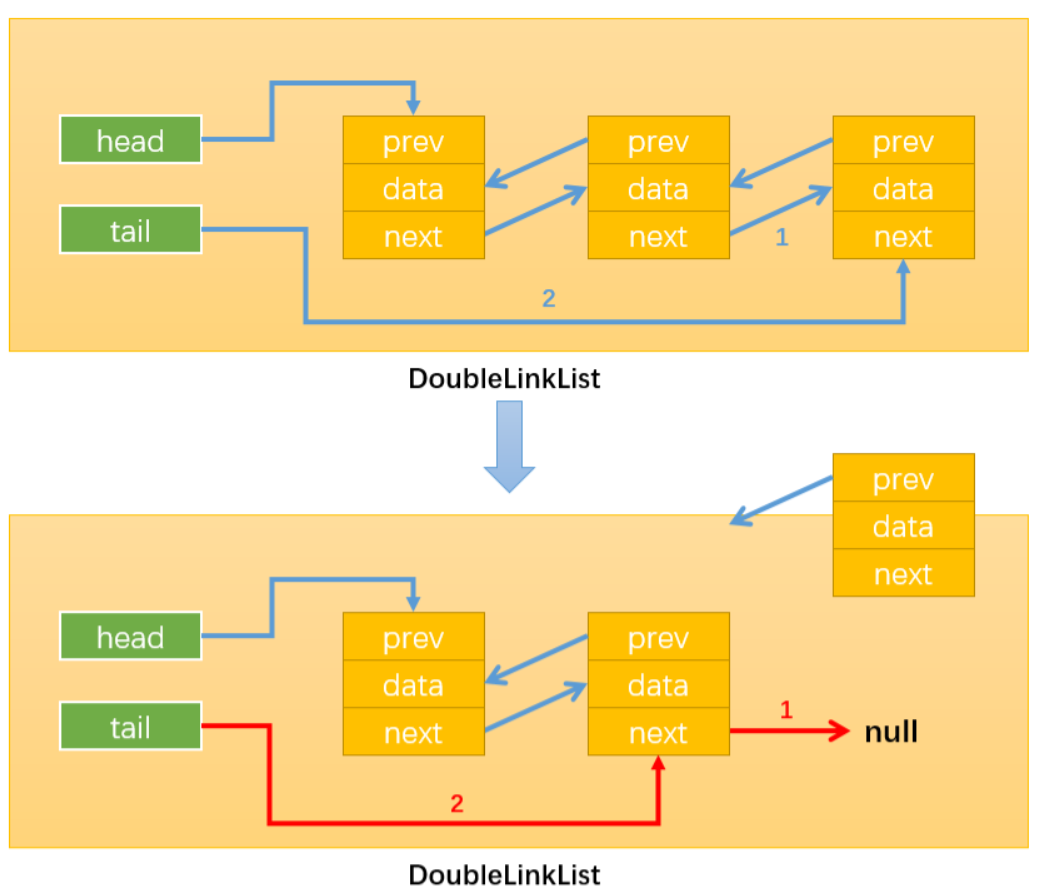
情况4:删除链表中间的节点:
通过while循环找到需要删除的节点,比如position = x,那么需要删除的节点就是Node(x+1),如下图所示:
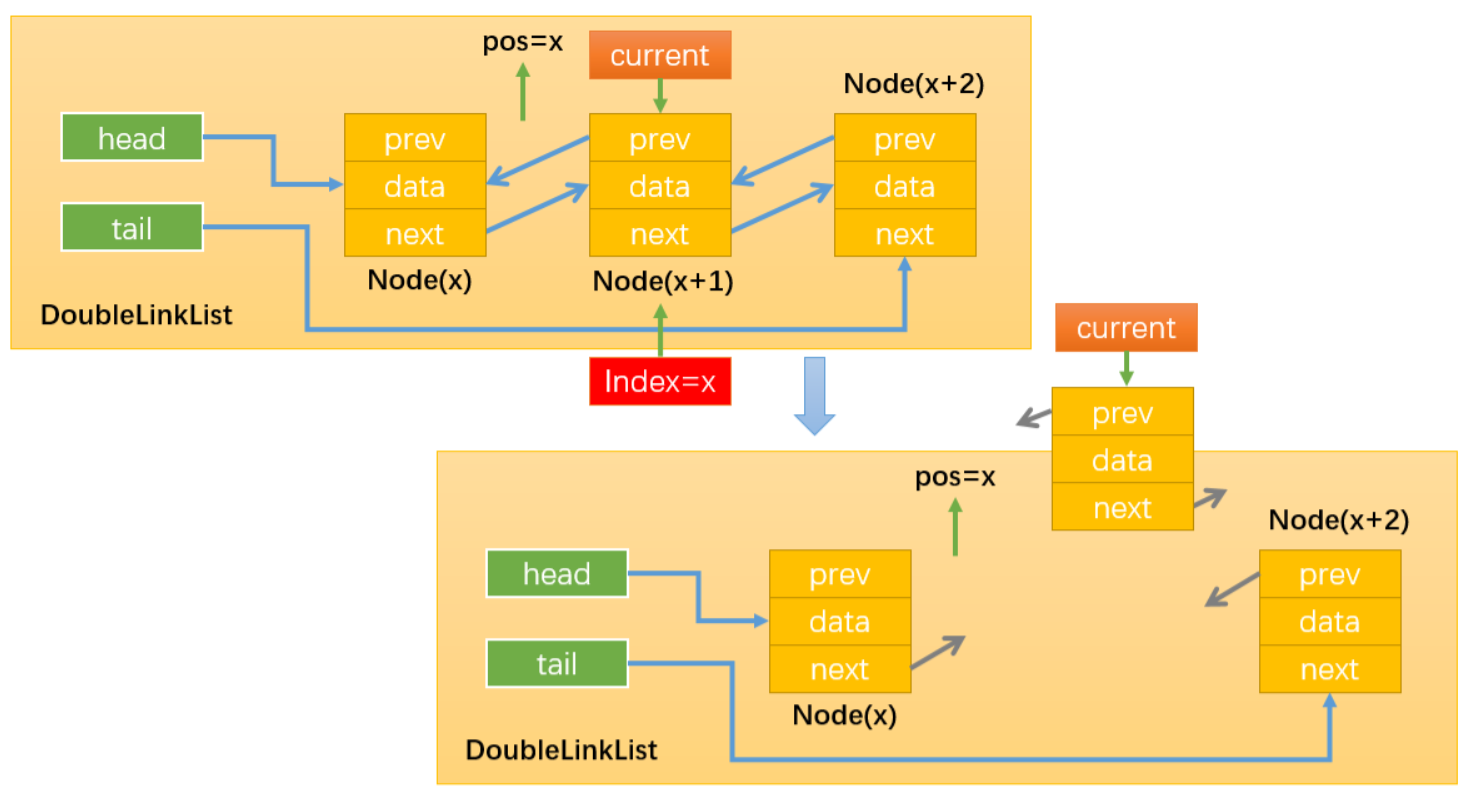
通过:current.next.prev = current.prev,修改指向1;
通过:current.prev.next = current.next,修改指向2;
这样就没有引用指向Node(x+1)了(current虽指向Node(x+1),但current时临时变量,该方法执行完就会被销毁),随后Node(x+1)就会被自动删除。
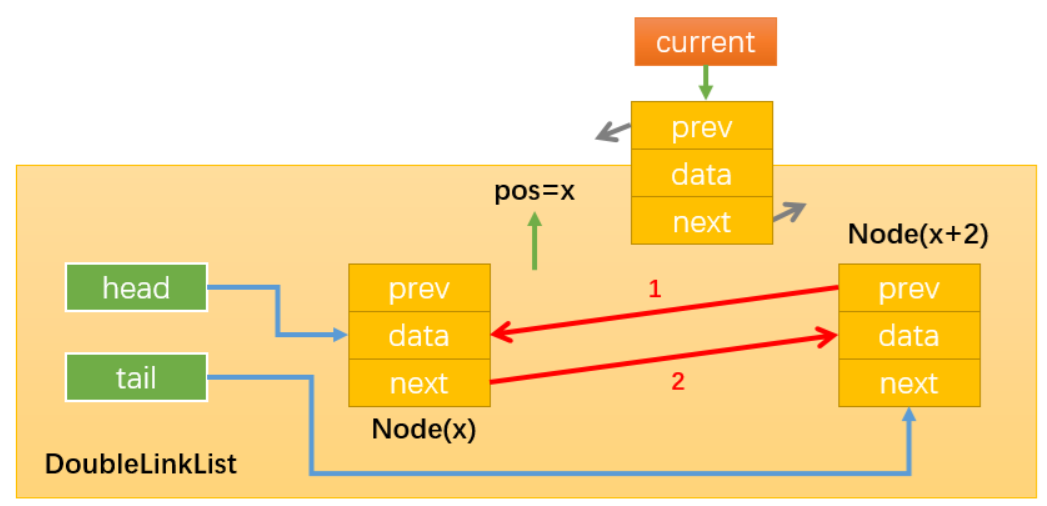
remove(element)、isEmpty()、size()、getHead()、getTail()
/*--------------------其他方法-------------------*/
//八.remove方法
DoubleLinklist.prototype.remove = data => {
//1.根据data获取下标值
let index = this.indexOf(data)
//2.根据index删除对应位置的节点
return this.removeAt(index)
}
//九.isEmpty方法
DoubleLinklist.prototype.isEmpty = () => {
return this.length == 0
}
//十.size方法
DoubleLinklist.prototype.size = () => {
return this.length
}
//十一.getHead方法:获取链表的第一个元素
DoubleLinklist.prototype.getHead = () => {
return this.head.data
}
//十二.getTail方法:获取链表的最后一个元素
DoubleLinklist.prototype.getTail = () => {
return this.tail.data
}
测试代码
//测试代码
//1.创建双向链表
let list = new DoubleLinklist()
/*------------其他方法的测试--------------*/
list.append('a')
list.append('b')
list.append('c')
list.append('d')
//remove方法
console.log(list.remove('a'));
console.log(list);
//isEmpty方法
console.log(list.isEmpty());
//size方法
console.log(list.size());
//getHead方法
console.log(list.getHead());
//getTead方法
console.log(list.getTail());
完整实现
//封装双向链表
function DoubleLinklist(){
//封装内部类:节点类
function Node(data){
this.data = data
this.prev = null
this.next = null
}
//属性
this.head = null
this.tail ==null
this.length = 0
//常见的操作:方法
//一.append方法
DoubleLinklist.prototype.append = data => {
//1.根据data创建新节点
let newNode = new Node(data)
//2.添加节点
//情况1:添加的是第一个节点
if (this.length == 0) {
this.tail = newNode
this.head = newNode
//情况2:添加的不是第一个节点
}else {
newNode.prev = this.tail
this.tail.next = newNode
this.tail = newNode
}
//3.length+1
this.length += 1
}
//二.将链表转变为字符串形式
//2.1.toString方法
DoubleLinklist.prototype.toString = () => {
return this.backwardString()
}
//2.2.forwardString方法
DoubleLinklist.prototype.forwardString = () => {
//1.定义变量
let current =this.tail
let resultString = ""
//2.依次向前遍历,获取每一个节点
while (current) {
resultString += current.data + "--"
current = current.prev
}
return resultString
}
//2.3.backwardString方法
DoubleLinklist.prototype.backwardString = () => {
//1.定义变量
let current = this.head
let resultString = ""
//2.依次向后遍历,获取每一个节点
while (current) {
resultString += current.data + "--"
current = current.next
}
return resultString
}
//三.insert方法
DoubleLinklist.prototype.insert = (position, data) => {
//1.越界判断
if (position < 0 || position > this.length) return false
//2.根据data创建新的节点
let newNode = new Node(data)
//3.插入新节点
//原链表为空
//情况1:插入的newNode是第一个节点
if (this.length == 0) {
this.head = newNode
this.tail = newNode
//原链表不为空
}else {
//情况2:position == 0
if (position == 0) {
this.head.prev = newNode
newNode.next = this.head
this.head = newNode
//情况3:position == this.length
} else if(position == this.length){
this.tail.next = newNode
newNode.prev = this.tail
this.tail = newNode
//情况4:0 < position < this.length
}else{
let current = this.head
let index = 0
while(index++ < position){
current = current.next
}
//修改pos位置前后节点变量的指向
newNode.next = current
newNode.prev = current.prev
current.prev.next = newNode
current.prev = newNode
}
}
//4.length+1
this.length += 1
return true//返回true表示插入成功
}
//四.get方法
DoubleLinklist.prototype.get = position => {
//1.越界判断
if (position < 0 || position >= this.length) {//获取元素时position不能等于length
return null
}
//2.获取元素
let current = null
let index = 0
//this.length / 2 > position:从头开始遍历
if ((this.length / 2) > position) {
current = this.head
while(index++ < position){
current = current.next
}
//this.length / 2 =< position:从尾开始遍历
}else{
current = this.tail
index = this.length - 1
while(index-- > position){
current = current.prev
}
}
return current.data
}
//五.indexOf方法
DoubleLinklist.prototype.indexOf = data => {
//1.定义变量
let current = this.head
let index = 0
//2.遍历链表,查找与data相同的节点
while(current){
if (current.data == data) {
return index
}
current = current.next
index += 1
}
return -1
}
//六.update方法
DoubleLinklist.prototype.update = (position, newData) => {
//1.越界判断
if (position < 0 || position >= this.length) {
return false
}
//2.寻找正确的节点
let current = this.head
let index = 0
//this.length / 2 > position:从头开始遍历
if (this.length / 2 > position) {
while(index++ < position){
current = current.next
}
//this.length / 2 =< position:从尾开始遍历
}else{
current = this.tail
index = this.length - 1
while (index -- > position) {
current = current.prev
}
}
//3.修改找到节点的data
current.data = newData
return true//表示成功修改
}
//七.removeAt方法
DoubleLinklist.prototype.removeAt = position => {
//1.越界判断
if (position < 0 || position >= this.length) {
return null
}
//2.删除节点
//当链表中length == 1
//情况1:链表只有一个节点
let current = this.head//定义在最上面方便以下各种情况返回current.data
if (this.length == 1) {
this.head = null
this.tail = null
//当链表中length > 1
} else{
//情况2:删除第一个节点
if (position == 0) {
this.head.next.prev = null
this.head = this.head.next
//情况3:删除最后一个节点
}else if(position == this.length - 1){
current = this.tail//该情况下返回被删除的最后一个节点
this.tail.prev.next = null
this.tail = this.tail.prev
}else{
//情况4:删除链表中间的节点
let index = 0
while(index++ < position){
current = current.next
}
current.next.prev = current.prev
current.prev.next = current.next
}
}
//3.length -= 1
this.length -= 1
return current.data//返回被删除节点的数据
}
/*--------------------其他方法-------------------*/
//八.remove方法
DoubleLinklist.prototype.remove = data => {
//1.根据data获取下标值
let index = this.indexOf(data)
//2.根据index删除对应位置的节点
return this.removeAt(index)
}
//九.isEmpty方法
DoubleLinklist.prototype.isEmpty = () => {
return this.length == 0
}
//十.size方法
DoubleLinklist.prototype.size = () => {
return this.length
}
//十一.getHead方法:获取链表的第一个元素
DoubleLinklist.prototype.getHead = () => {
return this.head.data
}
//十二.getTail方法:获取链表的最后一个元素
DoubleLinklist.prototype.getTail = () => {
return this.tail.data
}
}
链表结构总结
单向链表有head和next两个属性,双向链表有head、tail、next、prev四个属性。处理好它们的指向,相当于将它们正确地连接在一起,这样就组成了一条链,这就是简单链表的实现。
在实际开发中链表使用得非常多,比如Java中的LinkList就是双向链表。
注意点
在链表中current = current.next 可以从左往右看,看成是current --> current.next,即current指向current的下一个节点。
删除节点的原理:只要没有引用指向该对象,无论该对象是否有引用指向其他对象,该对象都会被回收(删除)。
参数中凡是有position的都要进行越界判断。
链表的增删改查
以双向链表为例:链表的增删改查无非就是获取链表中相应的节点改变其中的prev和next两个变量的指向。
情况一:只需要head和tail两个变量就可以获取需要操作的变量(这里指的是能够轻松获取,当然你想通过head.next.next...或tail.prev.prev...来获取想要的节点也可以),在这种情况下链表的长度length:0 <= length <=2。
情况二:不能靠tail和head来获取到需要操作的变量时,可采用while循环遍历的方式,找到需要操作的节点:
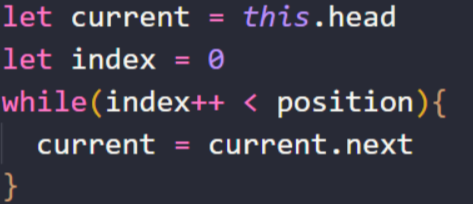
在这种情况下,如果我们想要在链表的position = x的位置插入新节点,那么可以通过current获取position的后一个节点Node(x+1),通过current.prev获取position位置的前一个节点Node(x);之后修改Node(x+1)和Node(x)中的prev和next两个变量的指向即可在pos=x 的位置插入新节点。
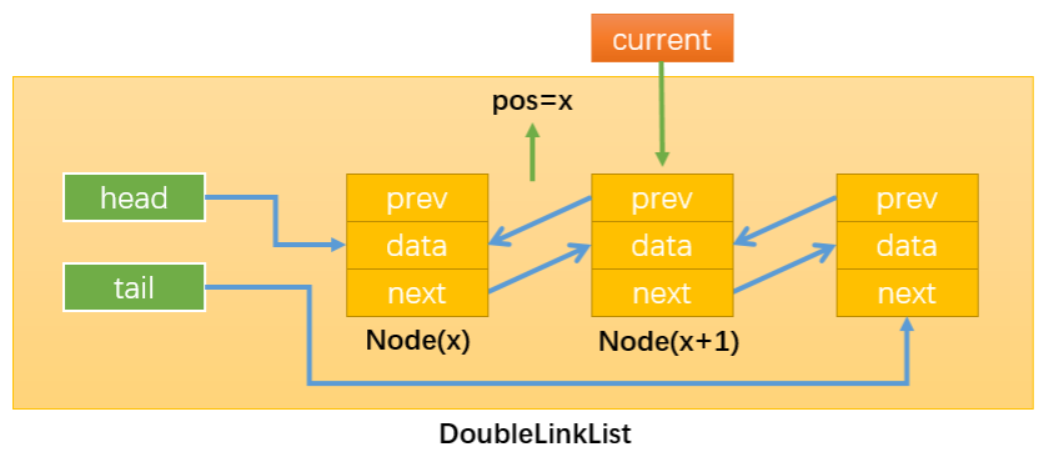
修改链表引用指向
应先修改newNode引用的指向,再修改其他引用
情况1:通过head和tail引用就能获取需要操作的节点时,最后更改head或tail变量的指向(因为它们分别指向链表的第一个和最后一个节点,获取其他节点时可能需要用到它们)。
情况2:使用current获取到需要操作的节点时,最后更改curren.next或current.prev的指向。因为current.next和current.prev表示的是Node(x+2)和Node(x)这两个节点,如下图所示,一旦变更它们的指向就无法获取Node(x)或Node(x+2)了,
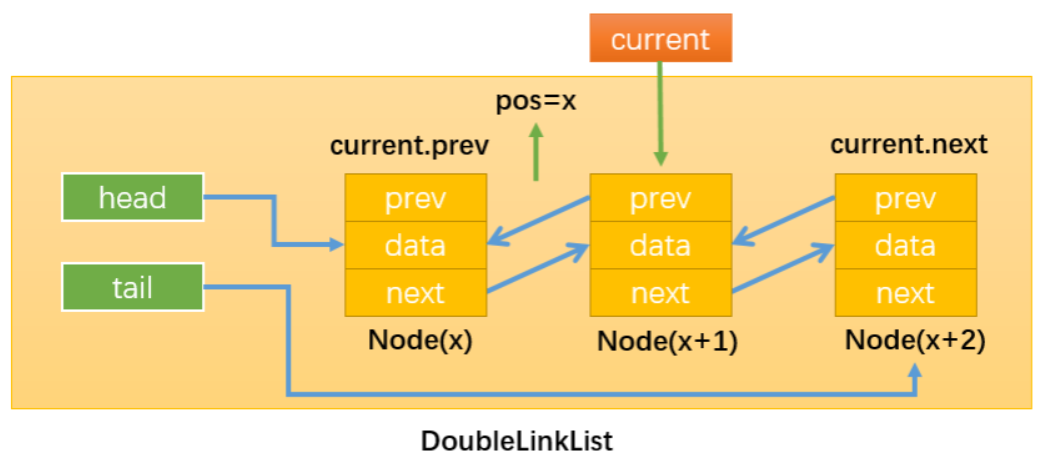
遍历链表
积累两种遍历思路
获取指定的position = x 位置的后一个节点和索引值:
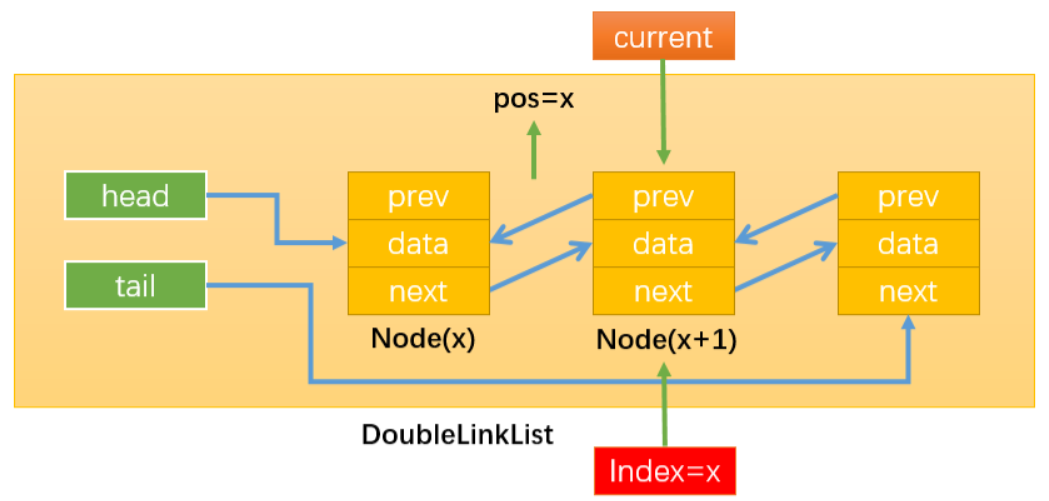
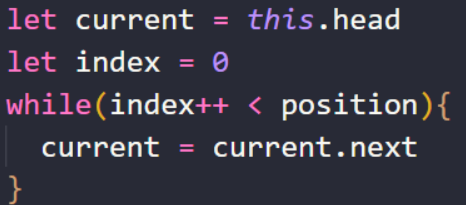
循环结束后index = position = x,变量current就指向了Node(x+1),变量index的值为Node(x+1)的索引值x。
遍历链表中的所有节点:


当current.next = null时停止循环,此时current指向链表的最后一个节点。